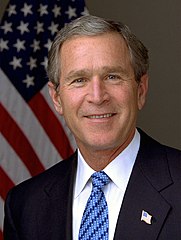Kathi Appelt (born Fayetteville, North Carolina, 1954) has written at least 40 books for children. Her novel The Underneath received a 2009 Newbery Honor Award. Appelt also wrote Before and After Otis. Children can visit her website at: Kathi Appelt.

George W. Bush
George W. Bush (born New Haven, Connecticut, 1946) was the forty-third president of the United States. He is a former governor of Texas. Children can visit a website at: George W. Bush.
Cheryl Harness (born Maywood, California, 1951) has written and illustrated at least 35 books for children. Her books include Mary Walker Wears the Pants and Just for You to Know. Children can visit her website at: Cheryl Harness.
Ekua Holmes (born Boston, Massachusetts, 1955) is an artist and children’s book illustrator. She received a 2016 Caldecott Honor Award for Voice of Freedom: Fannie Lou Hamer, Spirit of the Civil Rights Movement. She earned the 2018 Coretta Scott King Illustrator Award for Out of Wonder: Poems Celebrating Poets.
John Paul Jones (born Kirkbean, Scotland, 1747; died Paris, France, July 18, 1792) was a Revolutionary War hero. His name was really John Paul, but he added the names Jones when he fled a murder charge in the Caribbean and came to the United States. He was captain of the U. S. S. Bonhomme Richard and battled the British Serapis. When the British captain asked him if he was ready to surrender, he replied, “Sir, I have not yet begun to fight.”
Frida Kahlo (born Coyoacan, Mexico, 1907; died Coyoacan, Mexico, July 13, 1954) was a surrealist painter. She was the wife of Diego Rivera. Children can view some of her works at: Frida Kahlo.
Carol Lerner (born Chicago, Illinois, 1927) has written and illustrated about twenty books for children. Books include Butterflies in the Garden and Plants that Make You Sniffle and Sneeze.
Dhan Gopal Mukerji (born Kajangal, India, 1890; died New York, New York, July 14, 1936) was a writer. He received the 1928 Newbery Medal for Gay Neck, The Story of a Pigeon. Children could read his Kari the Elephant at: Project Gutenberg.

Nancy Reagan
Nancy Davis Reagan (born Anne Francis Robbins in New York, New York, 1921; died Los Angeles, California, March 6, 2016) was America’s First Lady from January 20, 1981 to January 20, 1989. She was the wife of Ronald Reagan, fortieth president of the United States. Her given name was Anne, but she was nicknamed Nancy as a small child. Her parents divorced, and her mother married Loyal Davis. He adopted Nancy. She became an actress and appeared in eleven movies. While she was First Lady, she directed major changes to the second and third floors of the White House. Children can visit a website at: Nancy Reagan.
Gloria Skurzynski (born Duquesne, Pennsylvania, 1930) has written more than 60 books for children. Her books include This Is Rocket Science and Are We Alone? Children can visit her website at: Gloria Skurzynski.

 Elizabeth Kortright Monroe (born New York, New York, 1768; died Oak Hill, Virginia, September 23, 1830) was America’s First Lady from March 4, 1817 to March 4, 1825. She was the wife of James Monroe, the fifth president of the United States. She was the daughter of a British soldier who decided to stay in America after the Revolutionary War. Since she and her husband had traveled so much during his career, she tried to model White House functions after those of Europe. Children can visit a website at: Elizabeth Monroe. Idea: Children might see if they can find out information on the fashions of her time. Did they dress fancily? Did they have extensive wardrobes?
Elizabeth Kortright Monroe (born New York, New York, 1768; died Oak Hill, Virginia, September 23, 1830) was America’s First Lady from March 4, 1817 to March 4, 1825. She was the wife of James Monroe, the fifth president of the United States. She was the daughter of a British soldier who decided to stay in America after the Revolutionary War. Since she and her husband had traveled so much during his career, she tried to model White House functions after those of Europe. Children can visit a website at: Elizabeth Monroe. Idea: Children might see if they can find out information on the fashions of her time. Did they dress fancily? Did they have extensive wardrobes?



